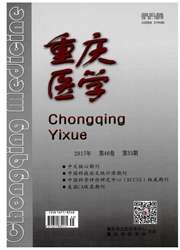

 中文摘要:
中文摘要:
目的:探讨加减三甲散对免疫损伤性肝纤维化大鼠治疗作用的分子机制。方法:SPF级Wistar雄性大鼠24只,随机分成正常组、模型组、加减三甲散组、阳性对照组(复方鳖甲软肝片)。常规饲养7d后给模型组、加减三甲散组、阳性对照组采用猪血清腹腔注射复制免疫性肝纤维化模型。造模后各组均灌胃给药,1次/d,加减三甲散组剂量为8.125g/kg,阳性对照组剂量为0.625g/kg,模型组及正常组予0.9%氯化钠溶液等体积灌胃。治疗60d后麻醉处死大鼠取肝脏,HE和MASSON染色观察病理形态,免疫组化CD34标记检测肝脏微血管密度(MVD),RTPCR和Western blot检测肝组织VEGF-αm RNA及蛋白表达。结果:CD34标记的内皮细胞或细胞丛颜色为浅黄色或棕黄色,CD34主要表达在细胞浆、细胞膜或间质中;与正常组比较,模型组大鼠MVD、HA、LN、VEGF-αm RNA及蛋白表达显著增高(P〈0.01,P〈0.05);与模型组比较,加减三甲散组及阳性对照组MVD、HA、LN、VEGF-αm RNA及蛋白表达显著下降(P〈0.05,P〈0.01)。结论:加减三甲散方可降低肝纤维化大鼠血清HA、LN含量,降低肝组织VEGF-αm RNA及蛋白表达水平,减少肝脏MVD,可能是其促进肝纤维化逆转与恢复的部分分子机制。
 英文摘要:
英文摘要:
Objective: To investigate molecular mechanism of Sanjia Power in the treatment of rats with immuno-hepatic fibrosis. Methods: Twenty-four SPF Wistar male rats were randomly divided into the control group, model group, Fufang Biejia Ruanjian Tablet group and modified Sanjia Power groups. Rats in all groups except for the control group were intraperitoneally injected with porcine serum to establish an immuno-hepatic fibrosis model. After modeling, the rats in modified Sanjia Power group received 8.125g/kg of modified Sanjia Power by gavage once a day, while the Fufang Biejia Ruanjian Tablet group received 0.625 g/kg of Fufang Biejia Ruanjian Tablet. The control group and model group received the same volume of normal saline by gavage. After 60 days, all rats were sacrificed to collect the liver. HE and MASSON staining were used to observe pathological morphology. The immunohistochemistry method was used to detect the expression of CD34, a maker of hepatic microvascular density(MVD). The m RNA and proteins expression of VEGF-α were detected by RT-PCR and Western blot, respectively. Results: The color of endothelial cells or cells clump marked by CD34 antibody present light yellow or claybank. CD34 mainly expressed in cytoplasm, cell membrane, or stroma. Compared with the control group, the protein expression of CD34 as well as the protein and m RNA expression of VEGF-α in the other groups was significantly increased(P〈0.01, P〈0.05). Compared with the model group, the protein expression of CD34 as well as the protein and m RNA expression of VEGF-α in the two treatment groups(P〈0.05, P〈0.01). Conclusion: Modified Sanjia Power could improve the immuno-hepatic fibrosis, whose mechanism underlying may associate with the decreases of the level of HA and LN in serum, m RNA and protein expression of VEGF-α and hepatic microvascular density.
 同期刊论文项目
同期刊论文项目
 同项目期刊论文
同项目期刊论文
 期刊信息
期刊信息
